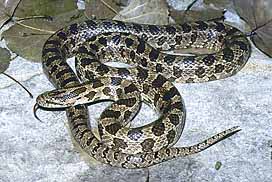Snakes
Description
30-52 1/8" (76.2-132.4 cm). A slender, variably patterned kingsnake. Tan, grayish-brown, or yellowish-brown above with black-edged, dark brown to reddish-brown or greenish blotches down back and 2 alternating rows of smaller, less conspicuous spots on sides. V-shaped arrowheadlike marking on crown of head. Pattern of older specimens may be lost or obscured by dark pigment; some develop 4 longitudinal dusky stripes. Scales smooth, in 21-27 rows. Anal plate single.
Subspecies
Prairie Kingsnake (L. c. calligaster),
scales in 25 or 27 rows; interspaces between blotches about equal in
size to blotch; belly white to yellowish, clouded or spotted with
brown; w. Illinois southwest to the Gulf in sc. Louisiana, west to
se. Nebraska, e. Kansas, Oklahoma, and e. Texas.
Mole Kingsnake
(L. c. rhombomaculata), scales in 21 or 23 rows; black blotches well
separated; belly yellow with brown rectangular blotches; c. Maryland
to n. Florida west to c. Tennessee and se. Louisiana.
South
Florida Mole Kingsnake (L. c. occipitolineata), similar to a young
Mole Kingsnake, with dark bordered brown to red blotches down back
and dark lines on head; isolated populations in ec.
Florida.
Breeding
Nests June to July. Female lays 5-17 eggs, 1 3/4-2" (44-51 mm) long, in earth cavity below ground surface. Young hatch in 7-11 weeks at 8-11" (20-28 cm), August to September.
Habitat
Open fields, cultivated farmland, barnyards, pastures, prairies, rocky hillsides, open woodland.
Range
C. Maryland to c. Florida west to se. Nebraska and e. Texas.
Discussion
Secretive; spends much of the day in animal burrows or under rocks or several inches of loose soil. Most frequently seen crossing roads after a rainstorm or on warm spring or summer nights. Eats small rodents, birds, frogs, lizards, and other snakes. Usually mild-tempered. One captive animal lived 11 years.


